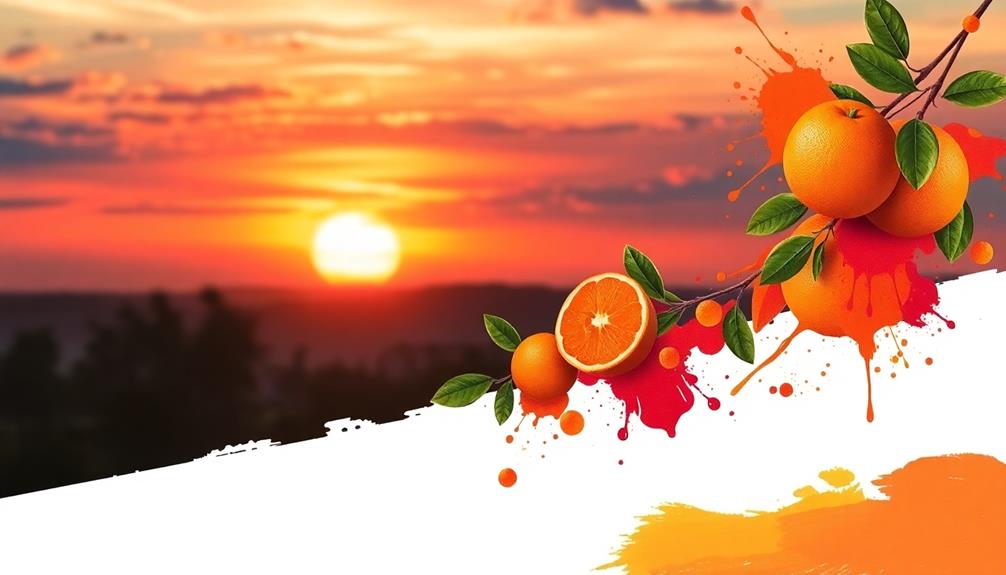A 401(k) plan is an employer-sponsored retirement savings account that helps you build a secure financial future. You can contribute on a pre-tax basis with a Traditional 401(k) or make after-tax contributions with a Roth 401(k). For 2024, you can contribute up to $23,000, plus an extra $7,500 if you're 50 or older. Employers often match contributions, maximizing your savings. You'll have a variety of investment options to choose from, too. Understanding the rules, like minimum distributions starting at age 73, is essential. Stick around because there's more you'll want to know about making the most of your 401(k)!
Key Takeaways
- A 401(k) plan is an employer-sponsored retirement savings account allowing pre-tax or after-tax contributions for future financial security.
- Traditional 401(k) contributions reduce taxable income, while Roth 401(k) allows for tax-free withdrawals under specific conditions.
- The contribution limit for 2024 is $23,000, with an additional $7,500 catch-up option for individuals aged 50 and older.
- Employer matching contributions can significantly increase retirement savings, with many companies matching up to 6% of employee contributions.
- Withdrawals from a Traditional 401(k) are taxable and incur penalties if taken before age 59½, while Roth 401(k) withdrawals may be tax-free under certain conditions.
Definition of a 401(k) Plan

A 401(k) plan is fundamentally an employer-sponsored retirement savings account designed to help you build a financial nest egg for your future. This plan allows you to make contributions from your salary, either on a pre-tax basis with a traditional 401(k) or after-tax with a Roth 401(k).
One of the main tax advantages of contributing to a traditional 401(k) is that it reduces your taxable income for the year, while Roth 401(k) contributions offer the benefit of tax-free withdrawals in retirement.
In 2024, you can contribute up to $23,000, with an additional catch-up contribution of $7,500 if you're aged 50 or older. The 401(k) plan promotes tax-deferred growth on your investments until you withdraw the funds, typically without penalties after you reach age 59½.
However, be cautious with early withdrawals, as they may incur a 10% penalty plus applicable taxes. With approximately 70 million individuals participating in 401(k) plans across the United States, it's clear that these accounts are an essential tool for accumulating retirement savings and securing your financial future.
Types of 401(k) Accounts
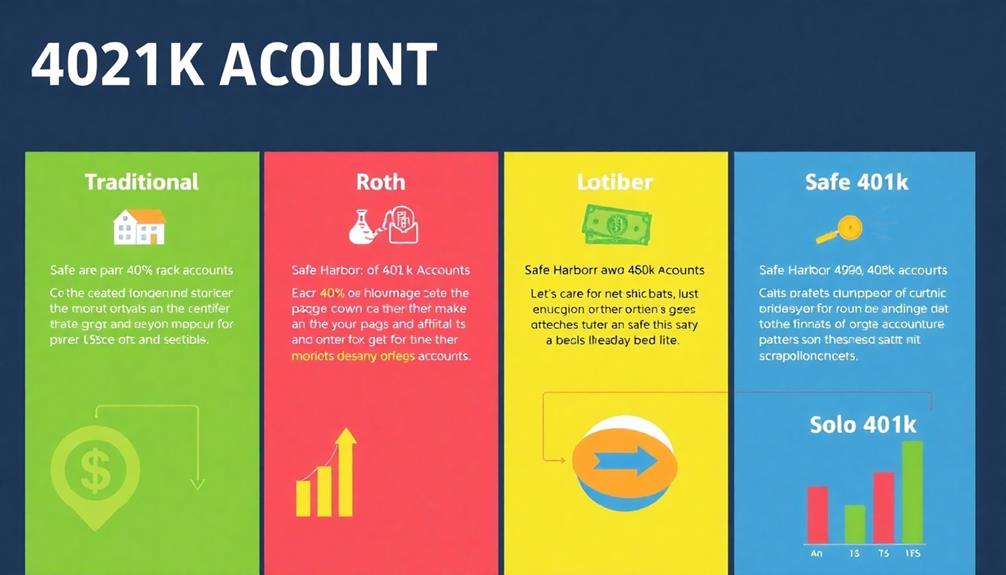
When it comes to 401(k) accounts, there are two primary types you should consider: the Traditional 401(k) and the Roth 401(k).
The Traditional 401(k) allows you to make pre-tax contributions, which reduces your taxable income now. You'll pay taxes when you withdraw the funds in retirement. This can be beneficial if you expect to be in a lower tax bracket later.
On the other hand, the Roth 401(k) requires after-tax contributions. This means you pay taxes upfront, but you can enjoy tax-free withdrawals in retirement, provided you meet certain conditions, like holding the account for at least five years.
Both 401(k) plans have the same annual contribution limits, which for 2024 are $23,000 for those under 50, plus an additional $7,500 catch-up contribution for those aged 50 and older.
Be mindful of the early withdrawal penalty; withdrawing funds before age 59½ typically incurs a 10% penalty, although exceptions exist.
Additionally, while Traditional 401(k)s require minimum distributions (RMDs) starting at age 73, Roth 401(k)s don't have RMDs during your lifetime, offering more flexibility in your retirement planning.
Contribution Limits and Rates
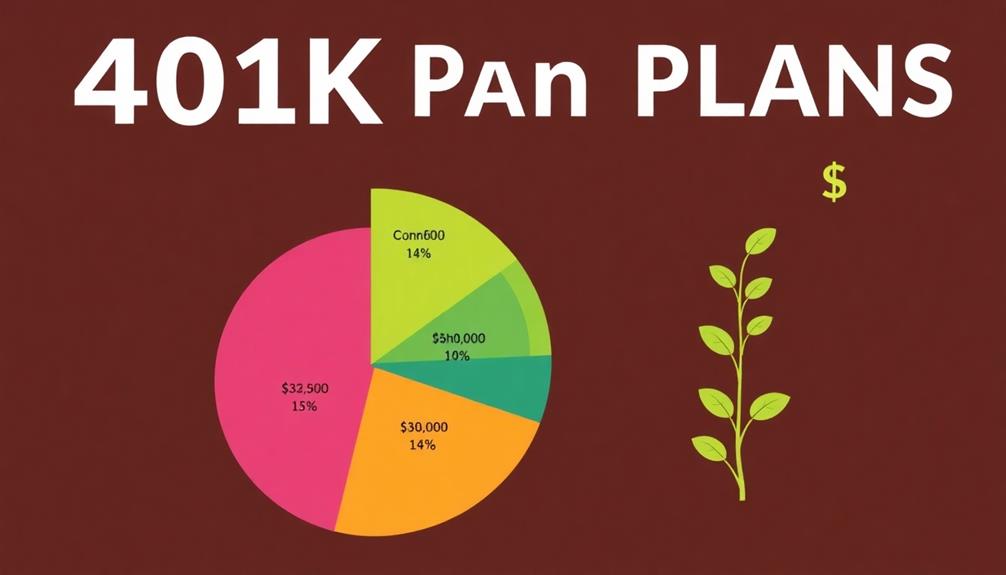
When planning your retirement savings, it's crucial to know the 2024 contribution limits for your 401(k).
If you're under 50, you can contribute up to $23,000, while those 50 and older have the option to add an extra $7,500 as a catch-up contribution.
Understanding these limits can help you maximize your retirement savings effectively.
2024 Contribution Limits
Understanding contribution limits is essential for maximizing your 401(k) savings. For 2024, the IRS has set the contribution limit for employees under 50 at $23,000. If you're aged 50 or older, you can make an additional catch-up contribution of $7,500.
This means that your total combined contribution limit—including employer contributions—rises to $69,000 for those under 50 and $76,500 for those 50 and older.
In 2023, the average employee contribution rate was about 7.1%, highlighting a positive trend in retirement savings. It's crucial to recognize that employer contributions don't count against your individual contribution limits, allowing you to maximize your retirement savings potential.
The IRS adjusts contribution limits annually, so keep an eye on future increases; for instance, limits will rise to $23,500 for employees under 50 and $31,500 for those 50+ by 2025.
Understanding these limits is a key part of your financial planning strategy, ensuring you're on track to meet your retirement goals. Make sure to stay informed so you can take full advantage of your 401(k) plans!
Catch-Up Contribution Options
For those aged 50 and older, catch-up contributions offer a valuable opportunity to boost your retirement savings as you near retirement. In 2024, you can contribute an additional $7,500 to your 401(k) plans, on top of the standard contribution limit of $23,000. This means your total contribution limit can reach $30,500, greatly enhancing your retirement funds.
It's essential to check your employer's plan to confirm that catch-up contributions are permitted and to understand any specific rules that may apply. Planning for retirement requires careful financial planning, especially if you started saving later in life.
Here's a quick overview of the catch-up contribution limits:
| Year | Age Group | Catch-Up Contribution |
|---|---|---|
| 2024 | 50 and older | $7,500 |
| 2025 | 60-63 | Up to $11,250 |
| 2024 | Total Limit | $30,500 |
| 2025 | Standard Limit | $23,500 |
| 2025 | 50 and older | $11,250 (if applicable) |
Utilizing catch-up contributions can be a game changer for your retirement savings strategy.
Employer Matching Contributions

Employer matching contributions can greatly boost your retirement savings.
You'll want to understand the different matching structures, like dollar-for-dollar or percentage-based matches, to maximize these benefits.
Matching Contribution Structures
A 401(k) plan often includes matching contributions, which can greatly enhance your retirement savings. Employers typically offer these contributions to incentivize you to save more. The most common structure is a dollar-for-dollar match on employee contributions, often up to a certain percentage of your salary. This means if you contribute, say, 6% of your salary, your employer will match that amount, effectively doubling your investment.
Here are some common matching contribution structures:
- Dollar-for-dollar match: Employers match your contributions dollar-for-dollar up to a specified percentage of your salary.
- Tiered matching structures: For example, a 50% match on employee contributions up to 4% of salary.
- Contribution limits: In 2024, the total contribution limit for employees under 50 is $23,000, allowing for increased savings potential.
- Secure full employer match: It's a risk-free way to boost your retirement savings considerably.
Understanding these matching structures can help you maximize your retirement plans and guarantee you're taking full advantage of your employer's contributions.
Don't leave money on the table—contribute enough to secure that full employer match!
Maximizing Employer Contributions
Maximizing employer contributions is a smart strategy that can greatly elevate your retirement savings. Many 401(k) plans offer employer matching contributions, with about 40% of companies matching up to 6% of employee contributions. Securing the full employer match is a risk-free way to boost your investment return, markedly enhancing your overall retirement savings.
| Contribution Type | Percentage Matched | Maximum Contribution (2024) |
|---|---|---|
| Employee Contributions | Up to 6% | $69,000 for under 50 |
| Employer Matches | Dollar-for-dollar | Included in combined limit |
| Total Savings | Combined efforts | Up to $69,000 |
Regularly reviewing and adjusting your contribution levels can help you qualify for the maximum employer match. This allows you to take full advantage of the combined contribution limit, leading to substantial long-term financial benefits. Remember, every dollar your employer contributes is a step closer to a secure retirement. Don't leave money on the table—maximize your employer matching to supercharge your 401(k) plans!
Investment Options Available

Wondering what investment options are available in a 401(k) plan? You'll find a diverse range of choices designed to meet your financial goals and risk tolerance.
Typically, 401(k) plans offer:
- Mutual funds: A mix of stocks and bonds, allowing for diversified investment.
- Target-date funds: These automatically adjust their asset allocation as you approach your retirement timeline, offering a more hands-off approach.
- Guaranteed investment contracts: Safe options that provide stable returns, suitable for conservative investors.
- Self-directed brokerage accounts: For those wanting more control, these accounts let you invest in individual stocks, bonds, and exchange-traded funds (ETFs).
When selecting your investment options, it's essential to review the prospectus of each choice.
Understanding the associated risks, fees, and objectives will help you align your investment strategies with your retirement savings goals.
Keep in mind that the performance of your investments can greatly impact your financial future, so choose wisely based on your unique circumstances.
Withdrawal Rules and Penalties
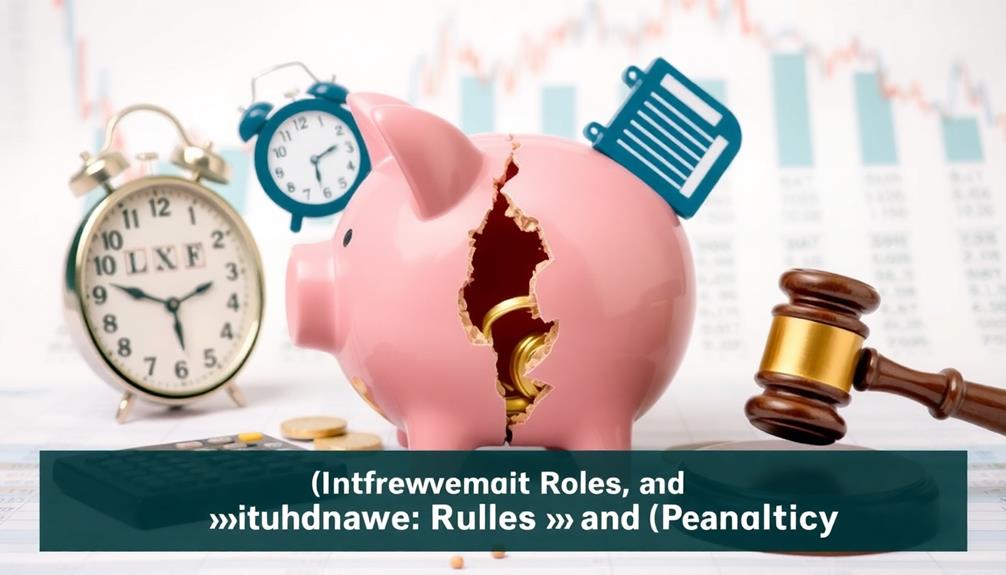
Understanding your investment options is just the beginning; knowing how and when you can access your 401(k) funds is equally important. Withdrawals from a traditional 401(k) are generally allowed without penalties after age 59½. However, if you take early withdrawals, you'll face a 10% penalty plus applicable taxes.
In certain situations, hardship withdrawals may permit access to your funds before age 59½, but keep in mind these are also subject to income tax and the 10% penalty. Loans against 401(k) balances can be an option too, as some employers allow you to borrow from your retirement savings without incurring penalties, provided you repay on time.
For traditional 401(k) accounts, Required Minimum Distributions (RMDs) must begin at age 73, which are considered taxable income. Conversely, Roth 401(k) accounts don't have RMDs during your lifetime, offering more flexibility in your retirement planning.
| Type of Withdrawal | Key Points |
|---|---|
| Traditional 401(k) | Penalties for early withdrawals |
| Hardship Withdrawals | Taxable, 10% penalty, qualifying circumstances |
| Loans | No penalties if repaid on time |
| RMDs | Begin at age 73, taxable income |
| Roth 401(k) | No RMDs during your lifetime |
Required Minimum Distributions

Once you hit age 73, you'll need to start taking Required Minimum Distributions (RMDs) from your traditional 401(k).
Understanding how to optimize your retirement through tailored retirement solutions can be beneficial as you navigate these withdrawals.
Calculating how much you need to withdraw can get tricky, especially if you have multiple accounts.
Plus, it's important to understand the tax implications of these withdrawals to avoid costly penalties.
RMD Age Requirements
At age 73, you'll need to start taking Required Minimum Distributions (RMDs) from your traditional 401(k) account, though if you were born in 1960 or later, that age rises to 75. Understanding these age requirements is essential to avoid hefty penalties.
Here are some key points about RMDs:
- RMDs apply only to traditional 401(k) accounts; Roth 401(k)s are exempt during your lifetime.
- The amount you must withdraw is based on your account balance from December 31 of the previous year.
- The IRS provides a specific distribution period to determine how much you need to take out.
- If you fail to take your RMD, you could face a penalty of 25% on the amount you should have withdrawn.
It's important to calculate RMDs separately for each of your retirement accounts to comply with the IRS distribution rules.
Staying informed about these requirements will help you manage your finances effectively and avoid unnecessary penalties as you approach retirement.
Calculating RMD Amounts
Calculating your Required Minimum Distributions (RMDs) is an important step after reaching age 73. As a traditional 401(k) account holder, you must adhere to IRS regulations that require you to begin taking RMDs. To determine your RMD amount, divide your account balance from December 31 of the previous year by the IRS-assigned distribution period based on your life expectancy.
If you have multiple tax-deferred accounts, remember that you need to calculate RMDs separately for each one. It's essential to take the full RMD; failing to do so could lead to a hefty penalty of 25% on the amount you should have withdrawn, which can greatly impact your retirement savings.
On the other hand, if you have a Roth 401(k) account, you're in luck! These accounts are exempt from RMD requirements during your lifetime, allowing for tax-free growth without mandatory withdrawals.
This flexibility can be beneficial for your long-term financial strategy, enabling you to let your investments grow without the pressure of RMDs. Be sure to stay on top of your calculations to avoid any unexpected penalties!
RMD Tax Implications
Understanding the tax implications of Required Minimum Distributions (RMDs) is crucial for managing your retirement savings effectively. As a traditional 401(k) account holder, you must start taking RMDs by age 73. The amounts you withdraw are treated as ordinary income, which means they can impact your overall tax bracket for the year.
Additionally, it's essential to highlight that RMD rules can vary based on your specific retirement account type and beneficiary designations. If you fail to withdraw the required amount, you could face a hefty penalty tax of 25% on the undistributed funds, which greatly reduces your retirement savings.
Here are some key points to reflect on regarding RMD tax implications:
- RMDs must begin by April 1 following your 73rd birthday.
- The RMD amount is calculated based on your account balance and the IRS-assigned distribution period.
- Withdrawing funds can push you into a higher tax bracket, increasing your tax burden.
- Roth 401(k) accounts allow for tax-free growth and don't require RMDs during your lifetime.
Being proactive and understanding these tax implications can help you optimize your retirement strategy and preserve your savings.
Pros and Cons of 401(k) Plans
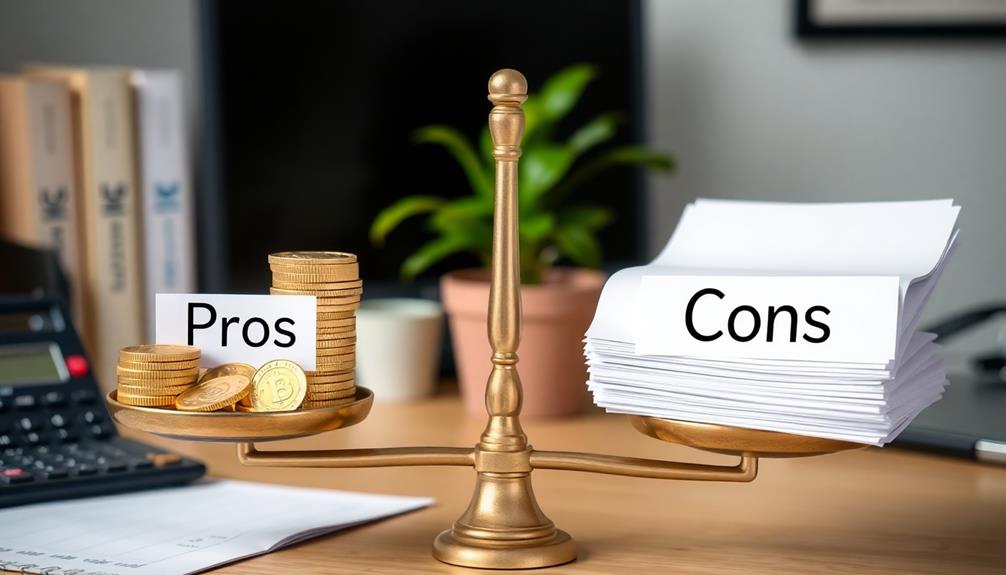
When evaluating retirement savings options, 401(k) plans present a mix of advantages and disadvantages that can greatly impact your financial future. One major benefit is tax-deferred growth on investments, allowing you to save for retirement without immediate tax implications on your contributions. This can markedly enhance your long-term savings.
Additionally, many employers offer matching contributions, with around 40% matching up to 6% of your contributions, effectively boosting your retirement savings at no extra cost. Moreover, diversifying your investment strategy by exploring options like a Gold IRA can provide added protection against market volatility and inflation, which is vital in today's economy diversification of retirement portfolio.
However, there are drawbacks to examine. Early withdrawals from your 401(k) plan before age 59½ incur a 10% penalty, plus applicable income taxes, which can hinder access to funds in emergencies.
Moreover, Required Minimum Distributions (RMDs) must start at age 73 for traditional 401(k) plans, potentially forcing you to withdraw funds and face tax implications, even if you don't need the money.
Lastly, while 401(k) plans provide diverse investment options such as mutual funds and ETFs, which allow you to tailor your strategy, it's important to weigh these pros and cons carefully to make informed decisions about your retirement savings.
Impact of Job Changes

Changing jobs can greatly affect your retirement savings, especially your 401(k) plan. When you switch employers, you have several options for handling your 401(k) funds. It's important to grasp these choices to avoid tax implications and optimize your retirement savings.
Here are four key options to evaluate:
- Rollover to a new 401(k): You can transfer your funds to your new employer's 401(k) plan to maintain tax-deferred growth.
- Rollover to an IRA: This option also keeps your savings tax-advantaged while giving you more investment choices.
- Leave it in the old plan: Your account can continue growing tax-deferred, but you can't make further contributions.
- Withdraw funds: Be cautious, as taking money out may lead to taxes and penalties if you're under 59½.
Completing a rollover within 60 days is important to avoid taxes. If you don't, the amount could be treated as a taxable distribution.
Understanding these options after job changes is significant for effective retirement planning and maximizing your contributions toward a secure financial future.
Future Trends in 401(k) Plans

As the landscape of retirement planning evolves, many employees are noticing exciting trends in 401(k) plans that cater to their diverse financial needs.
One significant trend is the rising popularity of self-directed brokerage accounts, which give you greater control over your investment choices and support a personalized retirement savings strategy.
You're also likely to see more Roth options in 401(k) plans, allowing for tax-free withdrawals during retirement, which can be a game-changer for your financial planning.
Keep an eye on legislative changes that may affect contribution limits and tax benefits, as these adjustments can influence your ability to save effectively. It's essential to stay informed about these shifts.
Financial literacy and retirement planning education are gaining traction, helping you make smarter decisions about your investments and savings strategies.
Moreover, market downturns may present buying opportunities. Many experts recommend maintaining your investment positions during such times to capitalize on potential rebounds.
Frequently Asked Questions
What Is a 401K Plan and How Does It Work?
A 401(k) plan's an employer-sponsored retirement account where you contribute a portion of your salary. You can choose pre-tax or after-tax contributions, helping you save for retirement while potentially reducing your taxable income.
What Are the Disadvantages of a 401K?
When considering a 401(k), you should be aware of early withdrawal penalties, limited investment choices, high management fees, required minimum distributions, and the risk of inadequate retirement income. These factors can impact your financial security.
What Happens to Your 401K When You Quit?
Imagine your 401(k) as a garden. When you quit, you can choose to leave it untouched, transfer it to a new plot, or uproot it, risking penalties. Each choice shapes your financial future differently.
How Do 401K Payments Work?
You make 401(k) payments through payroll deductions, either pretax or after-tax. Your contributions grow tax-deferred, and your employer may match a portion, boosting your retirement savings as you adjust your contributions anytime.
Conclusion
As you navigate the winding road of retirement planning, think of your 401(k) as a sturdy bridge that connects your present to your future. With its variety of options and potential growth, it's a powerful tool in your financial toolkit. Embrace its benefits, but stay mindful of the pitfalls. By understanding how to maximize this plan, you're not just building a nest egg; you're crafting a safety net that will support you when it matters most.





